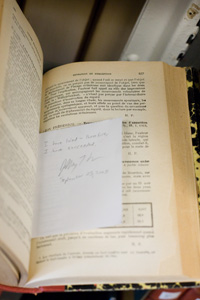Note to my future self
It’s easy to get lost in the libraries at Stanford. Though not the largest university library system, it still holds almost 9 million volumes.
I was wandering through the stacks in the Green library today. Many books appeared to have gone years without feeling the loving touch of human hands. The situation called for an experiment: how ignored were the volumes?
I went to an obscure corner of the library and selected a very old book, one that seemed to have sat idle since not long after its 1923 printing. I opened it to a random page and slipped in a note to myself:

The note says: “I have tried — therefore, I have succeeded. <Signed> Jeff Keacher, September 25, 2008”
I plan to visit the book again, some time in the future, to see if the note remains in place.

Recent Comments